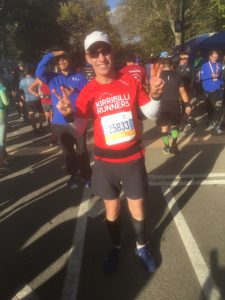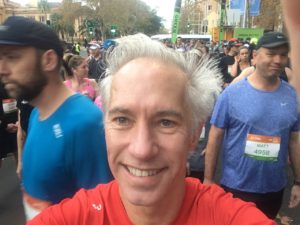Proximal Hamstring Tendinopathy: Richard’s Success Story
Introduction
In today’s episode, we have a success story to share – Richard’s journey through Proximal Hamstring Tendinopathy (PHT). Unlike the traditional narrative of progressing through injury, finding solutions, and ultimately achieving success, we’ll explore Richard’s unique experience and the strategies that helped him overcome PHT. Richard faced a five-year battle with PHT, overcame it, but then encountered a resurgence during the lockdown last year. He generously shared his insights and successful rehab strategies, including loading and pain management, recovery days, sleep, training intensities, weight training, timeframes, and various treatment modalities.
Let’s dive into Richard’s story and discover valuable lessons that can benefit anyone dealing with PHT or High Hamstring Tendinopathy.
Richard’s Initial Battle with Proximal Hamstring Pain
Richard, a specialist doctor with a passion for exercise, is an active member of the community involved in promoting physical activity, particularly in older individuals. He’s been an advocate for Park Run and a member of Kirribilli Runners. Despite his active lifestyle, Richard faced a five-year battle with PHT, and today, he’ll shed light on his experience and recovery.
Richard’s encounter with PHT dates back to 2009 when he sustained a high hamstring injury while playing soccer, just before participating in the World Masters event. Despite the initial injury, he decided to push through, leading to prolonged suffering. Over the years, the pain began to impact not only his running but also simple activities like walking and sitting. He revealed that mismanagement was a significant factor during this period. However, when he adopted a more comprehensive and patient-centered approach to managing his condition, progress became evident.
Developing Hamstring Pain Awareness
Richard emphasized the importance of listening to your body. While running with PHT, it’s essential to assess your pain level. Mild pain that doesn’t hinder your running or cause limping may be acceptable. However, if your run isn’t working out, it’s crucial to acknowledge that some days aren’t meant for pushing through pain. Learning to find the right balance and respecting your body’s signals is key.
Over time, Richard learned to gauge his pain tolerance by reflecting on past experiences. He highlighted the significance of pain not only during but also in the days following a run. Recognizing the acceptable level of pain that doesn’t lead to aggravation is crucial. This self-awareness aids in fine-tuning your running and recovery strategies.
The Importance of Recovery and Sleep
Richard underscored the significance of recovery days and quality sleep. Tendons adapt and heal during the recovery phase after exercise, not during the activity itself. Prioritizing good sleep, maintaining a sleep schedule, and avoiding sleep disruptors like caffeine and alcohol are essential for optimal recovery.
Richard recommended the book “Why We Sleep” by Matthew Walker, a professor of physiology, as a valuable resource emphasizing the importance of sleep. Sleep plays a pivotal role in recovery, promoting the production of growth hormones and testosterone, vital for healing. Quality sleep is a cornerstone of tendon health and overall performance.
Listening to Your Body and Managing Pain
Richard stressed the importance of tuning into your body and respecting its limits. For runners, it’s crucial to establish your current capacity and the adaptation zone without exceeding it. This ensures that the body builds up rather than breaks down, reducing the risk of injury.
Implementing the 80-20 Rule
Richard advocated for the 80-20 rule, where 80% of runs should be easy, low-intensity runs, while only 20% should involve speed work or intervals. Balancing the types of runs throughout the week helps prevent overexertion and promotes recovery.
Proximal Hamstring Tendinopathy & Strength Training
Strength training played a pivotal role in Richard’s recovery. Initially, he struggled with walking due to the severity of his condition, prompting him to explore gym-based strength training. Contrary to previous beliefs, lifting heavy weights proved highly beneficial for tendons. Strengthening these connective tissues is vital for improved running efficiency.
Richard shared that he saw significant improvements in strength and pain reduction within three to six months of consistent weight training. He stressed the importance of careful and gradual progression in weight selection – starting with a weight you can lift comfortably for ten repetitions and increasing it by about 10% each week.
He also highlighted the importance of ongoing strength training as a maintenance strategy. After experiencing a recurrence of PHT during the COVID-19 lockdown when he couldn’t access the gym, Richard realized that consistent strength training is essential for preventing reinjury and maintaining tendon health.
Richard’s Experience with Treatment Modalities
Richard explored various treatment modalities during his PHT journey, including PRP (Platelet-Rich Plasma) injections and dry needling. While these treatments provided temporary relief, he emphasized that they are not standalone solutions and should be viewed as part of a comprehensive rehab program.
Platelet-Rich Plasma (PRP) Injections
PRP injections involve extracting platelets containing growth factors from the patient’s blood and injecting them into the affected area. Richard noted that while PRP initially helped, its effects diminished over time. He advised seeking experienced sports physicians if considering PRP treatment, as it may offer benefits for some individuals.
Dry Needling
Dry needling, similar to acupuncture, is a technique involving the insertion of needles into affected muscles. Richard found dry needling to provide symptomatic relief but not a long-term solution for healing tendinopathy. It’s valuable for reducing pain and discomfort but should be combined with a broader rehabilitation plan.
Avoiding Anti-Inflammatory Medications
Richard cautioned against the frequent use of anti-inflammatory medications. While these drugs may provide temporary relief, they can mask pain and potentially exacerbate the injury by allowing individuals to push through activities that would otherwise be painful. It’s essential to address the root cause of PHT through rehab and strength training instead of relying solely on painkillers.
Patience and Timeframes
Richard emphasized that recovery from PHT is a slow process, typically spanning several months to years. Patience is key, and it’s essential to stay committed to the rehabilitation process, even when progress seems slow or plateaus.

Tendinopathy Final Thoughts
Richard’s journey through Proximal Hamstring Tendinopathy is a testament to the importance of a multifaceted approach to rehabilitation. Key takeaways include:
- Listening to your body: Assess pain levels and respect your body’s signals.
- Prioritizing recovery and sleep: Quality sleep and recovery days are crucial for tendon health.
- Managing pain: Stay within your capacity to avoid injury aggravation.
- Implementing strength training: Gradual, progressive weight training is vital for tendon health.
- Exploring treatment modalities: Consider PRP and dry needling as part of a broader rehab plan.
- Avoiding anti-inflammatory medications: Rely on rehab and strength training instead.
- Being patient: Understand that recovery takes time and commitment.

